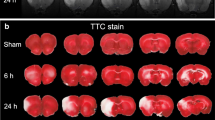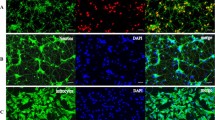Abstract
Gadolinium (Gd3+) complexes are important contrast agents in medical magnetic resonance imaging (MRI) and of great potential value in brain research. In order to better understand the mechanisms of the action of Gd3+ on neurons in the complex central nervous system (CNS), the neurotoxic actions of GdCl3 have been investigated in both neuron monoculture and astrocyte-neuron co-culture systems. Measurements of lactate dehydrogenase release showed that GdCl3 causes significant cell death of monocultured neurons as a result of reactive oxygen species (ROS) generation and down-regulation of brain-derived neurotrophic factor (BDNF). However, GdCl3 does not affect the viability and BDNF expression of astrocytes. Both co-culturing of neurons with astrocytes and addition of BDNF ameliorated GdCl3-induced neurotoxicity by decreasing ROS generation and facilitating recovery of BDNF levels. The results obtained suggest that astrocytes in the CNS may protect neurons from GdCl3-induced impairment through secreting BDNF and thus up-regulating BDNF expression and interfering with Gd3+-induced cell signaling in neurons. A possible molecular mechanism is suggested which should be helpful in understanding the neurotoxic actions of gadolinium probes.
Similar content being viewed by others
References
Bellin MF, van der Molen AJ. Extracellular gadolinium-based contrast media: An overview. Eur J Radiol, 2008, 66: 160–167
Xia Q, Han HB. The diffusion of Gd-DTPA in brain ECS studied by MRI. J Biol Inorg Chem, 2009, 14(Suppl 1): S162 (P254)
Abraham JL, Thakral C, Skov L, Rossen K, Marckmann P. Dermal inorganic gadolinium concentrations: evidence for in vivo transmetallation and long-term persistence in nephrogenic systemic fibrosis. Br J Dermatol, 2008, 158: 273–280
Fan G, Yuan Z, Zheng H, Liu Z. Study on the effects of exposure to rare earth elements and health-responses in children aged 7–10 years (in Chinese). J Hyg Res, 2004, 33: 23–28
Zhu WF, Xu SQ, Shao PP, Zhang H, Feng J, Wu DS, Yang WJ. Investigation of children intelligence quotient in REE mining area: Bio-effect study of REE mining area in South Jiangxi. Chin Sci Bull, 1996, 41: 914–916
Feng L, Xiao H, He X, Li Z, Lia F, Liu N, Zhao Y, Huang Y, Zhang Z, Chai Z. Neurotoxicological consequence of long-term exposure to lanthanum. Toxicol Lett, 2006, 165: 112–120
Yang W, Zhang P, Liu J, Xue Y. Effect of long-term intake of Yb3+ in drinking water on gene expression in brains of rats. J Rare Earths, 2006, 24: 369–373
Ray D E, Holton J, Nolan CC. Neurotoxic potential of gadodiamide after injection into the lateral cerebral ventricle of rats. Am J Neuroradiol, 1998, 19: 1455–1462
Toney GM, Chavez HA, Ibarra R. Acute and subacute physiological and histological studies of the central nervous system after intrathecal gadolinium injection in the anesthetized rat. Invest Radiol, 2001, 36: 33–40
Ricci G, Volpi L, Pasquali L, Petrozzi L, Siciliano G. Astrocyte-neuron interactions in neurological disorders. J Biol Phys, 2009, 35: 317–336
Legare ME, Barhoumi R, Hebert E, Bratton GR, Burghardt RC, Tiffany-Castiglioni E. Analysis of Pb2+ entry into cultured astroglia. Toxicol Sci, 1998, 46: 90–100
Dhandapani KM, Brann DW. Role of astrocytes in estrogen-mediated neuroprotection. Exp Gerontol, 2007, 42: 70–75
Arancibia S, Silhol M, Moulière F, Meffre J, Höllinger I, Maurice T, Tapia-Arancibia L. Protective effect of BDNF against β-amyloid induced neurotoxicity in vitro and in vivo in rats. Neurobiol Dis, 2008, 31: 316–326
Kirschner PB, Jenkins BG, Schulz JB, Finkelstein SP, Matthews RT, Rosen BR, Beal MF. NGF, BDNF and NT-5, but not NT-3 protect against MPP+ toxicity and oxidative stress in neonatal animals. Brain Res, 1996, 713: 178–185
Kume T, Kouchiyama H, Kaneko S, Maeda T, Kaneko S, Akaike A, Shimohama S, Kihara T, Kimura J, Wada K, Koizumi S. BDNF prevents NO mediated glutamate cytotoxicity in cultured cortical neurons. Brain Res, 1997, 756: 200–204
Petersén AA, Larsen KE, Behr GG, Romero N, Przedborski S, Brundin P, Sulzer D. Brain-derived neurotrophic factor inhibits apoptosis and dopamine-induced free radical production in striatal neurons but does not prevent cell death. Brain Res Bull, 2001, 56: 331–335
Liu H, Yuan L, Yang X, Wang K. La3+, Gd3+, and Yb3+ induced changes in mitochondrial structure, membrane permeability, cytochrome c release and intracellular ROS level. Chem-Biol Interact, 2003, 146: 27–37
Dong S, Zhao Y, Liu H, Yang X, Wang K. Duality of effect of La3+ on mitochondrial permeability transition pore depending on the concentration. BioMetals, 2009, 22: 917–926
Dugan LL, Bruno VM, Amagasu SM, and Giffard RG. Glia modulate the response of murine corticalneurons to excitotoxicity: glia exacerbate AMPA neurotoxicity. J Neurosci, 15: 4545–4555
Morken TS, Sonnewald U, Aschner M, Syversen T. Effects of methylmercury on primary brain cells in mono- and co-culture. Toxicol Sci, 2005, 87: 169–175
Raghavamenon AC, Gernapudi R, Babu S, D’Auvergne O, Murthy SN, Kadowitz PJ, Uppu RM. Intracellular oxidative stress and cytotoxicity in rat primary cortical neurons exposed to cholesterol secoaldehyde. Biochem Biophys Res Commun, 2009, 386: 170–174
Li XA, Lee AS. Competitive inhibition of a set of endoplasmic reticulum protein genes (GRP78, GRP94, and ERp72) retards cell growth and lowers viability after ionophore treatment. Mol Cell Biol, 1991, 11: 3446–3453
Kumar R, Agarwal AK, Seth PK. Oxidative stress-mediated neurotoxicity of cadmium. Toxicol Lett, 1996, 89: 65–69
Leonard SS, Harris GK, Shi X. Metal-induced oxidative stress and signal transduction. Free Radical Bio Med, 2004, 37: 1921–1942
Wang K, Cheng Y, Yang X, Li R. Cell responses to lanthanides and potential pharmacological actions of lanthanides. Metal Ions Biol Syst, 2003, 40: 707–751
Markham A, Cameron I, Franklin P, Spedding M. BDNF increases rat brain mitochondrial respiratory coupling at complex I, but not complex II. Eur J Neurosci, 2004, 20: 1189–1196
Jackson GR, Apffel L, Werrbach-Perez K, Perez-Polo JR. Role of nerve growth factor in oxidant-antioxidant balance and neuronal injury. I. Stimulation of hydrogen peroxide resistance. J Neurosci Res, 1990, 25: 360–368
Aharoni R, Eilam R, Domev H, Labunskay G, Sela M, Arnon R. The immunomodulator glatiramer acetate augments the expression of neurotrophic factors in brains of experimental autoimmune encephalomyelitis mice. Proc Nat Acad Sci, 2005, 102: 19045–19050
Toyomoto M, Ohta M, Okumura K, Yano H, Matsumoto K, Inoue S, Hayashi K, Ikeda K. Prostaglandins are powerful inducers of NGF and BDNF production in mouse astrocyte cultures. FEBS Lett, 2004, 562: 211–215
Feng XD, Xia Q, Liu HX, Han HB, Yang X, Wang K. The mechanism of actions of gadolinium chloride (GdCl3) on neurons. J Biol Inorg Chem, 2009, 14(Suppl 1): S119 (P063)
Shen C, Li Z, Yang X., Wang K. La3+ binds to BiP/GRP78 and induces unfolded protein response in HepG2 cells. Chem-Biol Interact, 2008, 176: 196–203
Saha RN, Liu X, Pahan K. Up-regulation of BDNF in astrocytes by TNF-α: A case for the neuroprotective role of cytokine. J Neuroimmune Pharmacol, 2006, 1: 212–222
Author information
Authors and Affiliations
Corresponding authors
Rights and permissions
About this article
Cite this article
Xia, Q., Feng, X., Yuan, L. et al. Brain-derived neurotrophic factor protects neurons from GdCl3-induced impairment in neuron-astrocyte co-cultures. Sci. China Chem. 53, 2193–2199 (2010). https://doi.org/10.1007/s11426-010-4105-x
Received:
Accepted:
Published:
Issue Date:
DOI: https://doi.org/10.1007/s11426-010-4105-x




